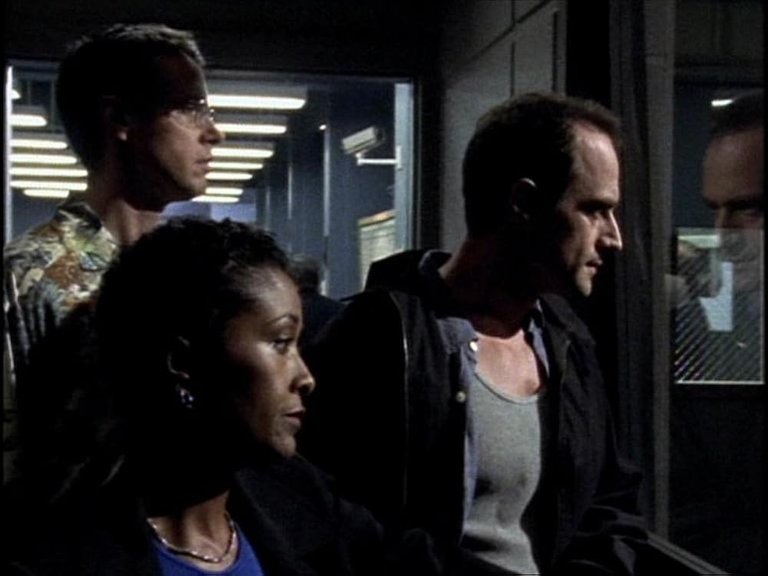Television Review: Wanted Dead or Alive: Part 2 (Homicide: Life on the Street, S7X07, 1998)

Wanted Dead or Alive: Part 2 (S07E07)
Airdate: 20 November 1998
Written by: Anya Epstein
Directed by: Robert Harmon
Running Time: 43 minutes
When a long-running or popular television series produces a two-part episode, the disparity in quality between the instalments often becomes stark. A strong opening segment frequently heralds a weaker second half, or vice versa. Wanted Dead or Alive: Part 2, the concluding segment of a two-part story in Homicide: Life on the Street, adheres to this pattern, with the second instalment undeniably falling short of its predecessor. Yet, the decline here is neither abrupt nor catastrophic, particularly given the show’s much-criticised final season. While the episode’s flaws are evident, it remains a competent entry, preserving the series’ trademark blend of procedural grit and humanistic storytelling.
The episode picks up immediately after the chaotic conclusion of its predecessor, focusing on the fallout from a vehicular pursuit that spiralled into a deadly car crash. FBI Agent Mike Giardello’s reckless driving during the chase for fugitive Joe Errico (Rico Rosetti) left Detective Meldrick Lewis critically injured and civilian Francine Bassent dead. Though Lewis ultimately survives and is recovering, the loss of Francine haunts her husband, Charles (Conrad Karlson), who vows to sue both Giardello and the city. Meanwhile, Assistant State Attorney Danvers delivers a cold legal verdict: Mike Giardello cannot be held criminally liable, as the law assigns responsibility to the criminal evading justice. This absolution shifts the Homicide Unit’s focus to capturing Errico, a priority that forces them to collaborate once more with the controversial bounty hunter David Knoll.
Knoll’s proficiency in tracking fugitives soon leads the team to South Beach, Florida, where Errico is hiding. Lt. Giardello, distrustful of bounty hunters, dispatches Detective Tim Bayliss instead of the case’s original lead, Detective Falsone. The Miami leg of the investigation offers a brief respite from Baltimore’s grim urban backdrop, but the episode’s tone remains pragmatic. The duo’s sojourn in Florida culminates in Errico’s capture, and a search of his home unearths his weapon, exonerating Knoll and his associates from accusations of wrongful death. The case concludes with a bittersweet resolution: while the Homicide Unit secures a win, Giardello and Lewis are burdened by guilt over the tragic consequences of their actions, particularly the elderly man who lost his wife of four decades.
A secondary subplot involving Detective Stuart Gharty adds texture but fails to match the main narrative’s emotional weight. Fharty faces financial ruin due to his impending divorce, responding with frustration and resentment toward his female colleagues. Their advice nudges him toward reconciliation, but he ultimately rejects compromise, opting instead to squander his assets and leave his wife penniless. While this thread underscores the show’s knack for exploring personal turmoil, it feels perfunctory compared to the primary storyline’s moral complexity. Gart’s arc, though relatable, hinges on clichéd marital strife, offering little fresh insight into his character.
Directed by Robert Harmon, best known for the 1980s cult horror film The Hitcher, and written by Anya Epstein, Wanted Dead or Alive: Part 2 maintains the series’ signature realism but struggles to transcend mediocrity. The episode’s strengths lie in its tight pacing, strong performances, and thematic depth, particularly in its portrayal of institutional and personal accountability. The decision to absolve Giardello legally yet burden him morally—through Lewis’s quiet anguish and Giardello’s acknowledgment of collateral damage—resonates with the show’s enduring preoccupation with ethical ambiguity. However, the narrative’s attempts to balance its gritty roots with commercial appeal occasionally undermine its gravitas.
The Miami interlude, while narratively functional, feels tonally discordant. The shift to a sun-drenched locale disrupts the series’ established aesthetic of urban decay, leaning into “hip” fan service for the male audience. Gratuitous beach scenes featuring women with silicone-enhanced breasts in revealing swimwear—a stark contrast to the episode’s otherwise grounded tone—hint at a calculated effort to attract viewership. These moments, though fleeting, betray the show’s earlier commitment to unflinching realism, serving as a concession to network pressures.
Ultimately, Wanted Dead or Alive: Part 2 is a serviceable but unremarkable entry in Homicide: Life on the Street’s final season. While its second instalment lacks the dramatic punch of the first, it retains the series’ core strengths: nuanced characterisation, procedural authenticity, and a willingness to dwell in moral grey areas. The episode’s flaws—its reliance on predictable subplots, tonal inconsistencies, and occasional lapses into sensationalism—reflect the broader decline of the season, yet it remains a testament to the show’s enduring capacity to provoke thoughtful engagement. For fans, it is a worthwhile watch, if only as a reminder of the series’ potential when its ambitions align with its execution.
RATING: 6/10 (++)
Blog in Croatian https://draxblog.com
Blog in English https://draxreview.wordpress.com/
InLeo blog https://inleo.io/@drax.leo
Hiveonboard: https://hiveonboard.com?ref=drax
Rising Star game: https://www.risingstargame.com?referrer=drax
1Inch: https://1inch.exchange/#/r/0x83823d8CCB74F828148258BB4457642124b1328e
BTC donations: 1EWxiMiP6iiG9rger3NuUSd6HByaxQWafG
ETH donations: 0xB305F144323b99e6f8b1d66f5D7DE78B498C32A7
BCH donations: qpvxw0jax79lhmvlgcldkzpqanf03r9cjv8y6gtmk9